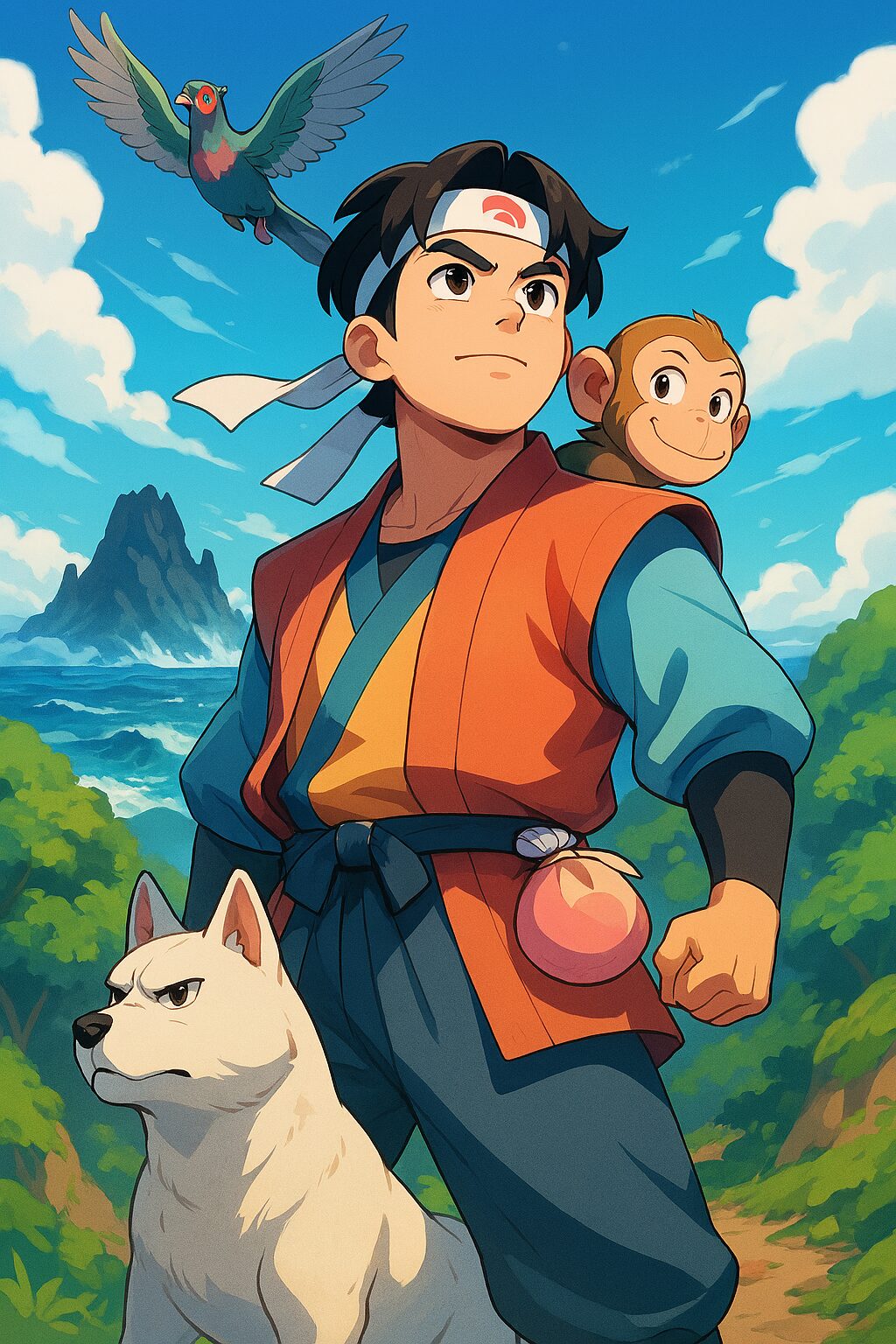- Momotaro: Japan’s Iconic and Immortal Hero’s Tale
- The Universality and Multilayered Analysis of “Momotaro”
- Deep Connections to Japanese Culture Revealed in the Folktale
- A Question for the Reader: What is Your “Momotaro Spirit”?
- Related Information
- 日本を代表する不朽の英雄譚:「桃太郎」
- 「桃太郎」の普遍性と多層的な考察
- 昔話から読み解く日本文化との深いつながり
- 読者への問いかけ:あなたの中の「桃太郎精神」とは?
- 関連情報
Momotaro: Japan’s Iconic and Immortal Hero’s Tale
The Full Story of “Momotaro” (The Peach Boy)
Long, long ago, in a mountain village, there lived an old man and an old woman who had no children. They lived a humble and peaceful life, gathering firewood and doing laundry by the river.
One day, a huge peach came floating down the river. The old woman happily took the peach home. When they prepared to cut it, the peach split open, and a baby boy sprang out! The couple, overjoyed, named the boy “Momotaro” (Peach Boy) and raised him with great care.
Momotaro grew into a strong young man with a strong sense of justice.
At that time, terrifying ogres (Oni) lived on “Onigashima” (Ogre Island), raiding villages and tormenting people.
Hearing the villagers’ distress, Momotaro resolved to go and defeat the wicked ogres. The old woman lovingly made the “Japan’s Best” millet dumplings (Kibi Dango) and tied them to his waist.
On his journey, Momotaro first met a dog. He gave the dog a Kibi Dango in exchange for its allegiance. Next, he met a monkey, and then a pheasant (Kiji), acquiring each as a retainer by sharing a Kibi Dango.
With the dog, monkey, and pheasant as his retainers, Momotaro sailed to Ogre Island. Using the pheasant for scouting, the monkey to open the gate, and the dog and his own sword for combat, Momotaro and his team defeated the ogres, forcing the general to surrender.
Momotaro returned triumphantly to the village with the recovered treasures. He was beloved by all and lived happily ever after with the old man and old woman. And so, the story ends happily.
The Universality and Multilayered Analysis of “Momotaro”
The tale of “Momotaro” is not just a simple children’s story; it holds important keys to understanding Japanese culture and spirituality.
1. The Allure of the Good vs. Evil Hero Tale
The most apparent theme is “**good triumphs over evil**” (Kanzan Choaku). The structure, where a protagonist with strength and justice restores peace, possesses a universal appeal that captures hearts across ages and borders.
2. “Kibi Dango” and “Companions”: The Importance of Leadership and Cooperation
The companions choose to become Momotaro’s retainers in exchange for the “**Kibi Dango**.” This dumpling is not just food; it can be interpreted as a **reward or a token of allegiance** to **Momotaro’s leadership**. The importance of utilizing diverse abilities and cooperating (a simultaneous attack from land, mountain, and sky) is a **universal lesson** applicable to modern team management.
3. The Sacredness and Origins of the “Peach”
The “**peach**” plays a crucial role. In ancient Japan, the peach was considered a **sacred fruit with powers of longevity and exorcism**. Momotaro’s birth from a peach suggests he is a **divine being with a celestial mission**, a “savior,” symbolizing **vitality and rebirth**.
Deep Connections to Japanese Culture Revealed in the Folktale
The narrative of “Momotaro” profoundly reflects Japanese spiritual culture and social structure.
1. The Spirit of “Filial Piety” and “Gratitude” (Hōon Kansha)
Momotaro fulfills his parents’ expectations and achieves the great task of ogre extermination. This strongly expresses the **spirit of “Kō” (filial piety)** towards one’s parents and the sense of “**Hōon Kansha**” (**gratitude**) for being raised, values highly esteemed in traditional Japanese ethics.
2. The Balance of “Public” and “Private”
Momotaro sets off for the “**public**” goal of “defeating the ogres.” This act—**dedicating individual power (private) for social stability (public)**—symbolizes the Japanese communal spirit and sense of duty.
3. What the “Ogres” of Ogre Island Symbolize
The “**ogres**” (Oni) carry significance beyond just being villains. They are seen as a symbol of **universal “evil,”** representing “**those who disrupt social order**” or “**the desires, laziness, and anger within the human heart**.”
A Question for the Reader: What is Your “Momotaro Spirit”?
“Momotaro” has continued to give courage and hope to people for centuries. We should question ourselves about the message within this tale.
What is “**Ogre Island**” for you? It might be a major challenge you need to overcome, or your own weaknesses.
And what is your “**Kibi Dango**”? It could be a talent, knowledge, or empathy you can share.
If you were Momotaro, to whom would you offer your “**Kibi Dango**,” and what would you want to achieve?
Related Information
External Links
- Japan Heritage: Okayama – The Birthplace of the Momotaro Legend (Momotaro Legend Promotion Council): Learn deeply about the “Legend of Kibitsuhiko-no-mikoto and Ura,” the prototype of the Momotaro tale.
- Structure and Transition of Japanese Folktales (Refer to specialized sites on Japanese folklore and ethnology)
Internal Links
- Japanese Folktale Series (The series homepage where this article is planned for publication)
「桃太郎」:不朽の英雄譚に隠された日本文化の真髄
日本を代表する不朽の英雄譚:「桃太郎」
昔話「桃太郎」の全容
昔々、ある山里に、子どものいないおじいさんとおばあさんが住んでいました。おじいさんは毎日山へ柴刈りに、おばあさんは川へ洗濯に出かけるという、慎ましくも穏やかな日々を送っていました。
ある日、おばあさんがいつものように川で洗濯をしていると、川上から、とてつもなく大きな桃が「ドンブラコッコ、スッコッコ」と流れてきました。「おや、これはいいお土産になるわい」とおばあさんは喜び、その桃を持ち帰りました。
夕方、おじいさんが山から帰り、二人で桃を食べようとすると、なんと桃がひとりでに割れ、中から元気な男の子が飛び出してきたではありませんか。子宝に恵まれなかった夫婦は、これを神様からの贈り物と大喜びし、桃から生まれたその子を「桃太郎」と名付けて、大切に育てました。
桃太郎は、すくすくと育ち、やがて日本一の力持ちで、正義感の強い立派な青年に成長しました。
その頃、都から遠く離れた海に浮かぶ「鬼ヶ島」には、恐ろしい鬼たちが住みつき、近隣の村々を襲っては、財宝や食料を奪い、人々を苦しめていました。
村人の苦しむ声を聞いた桃太郎は、「僕が鬼ヶ島へ行き、悪い鬼を退治して、宝物を取り返してきます!」と決意します。おじいさんとおばあさんは心配しましたが、桃太郎の固い決意に心打たれ、おばあさんは心を込めて「日本一」と謳われるきびだんごを作り、桃太郎の腰に下げさせました。
旅に出た桃太郎は、道中でまず一匹の犬に出会います。「桃太郎さん、お腰に下げているのは何ですか?」「これは日本一のきびだんごだ。」「そのきびだんごを一つくださるなら、お供させてください。」桃太郎はきびだんごを一つ与え、犬を家来にしました。
次に桃太郎は猿に出会います。「桃太郎さん、そのきびだんごを一つくださるなら、お供させてください。」桃太郎はきびだんごを一つ与え、猿を家来にしました。
さらに桃太郎は雉(きじ)に出会います。「桃太郎さん、そのきびだんごを一つくださるなら、お供させてください。」桃太郎はきびだんごを一つ与え、雉を家来にしました。
こうして、犬、猿、雉を家来にした桃太郎は、三匹と共に海を渡り、ついに鬼ヶ島へ上陸します。
鬼ヶ島の砦は鉄壁でしたが、空を飛べる雉が偵察し、猿が高い壁を乗り越えて門の閂(かんぬき)を外し、犬が鬼に噛みつき、桃太郎が刀を振るって鬼の大将と一騎打ちに挑みました。
犬、猿、雉の協力と、桃太郎の勇気と力によって、鬼たちは次々と打ち破られ、ついに鬼の大将も「もう二度と悪いことはしない。どうか命だけはお助けください」と降参しました。
桃太郎は、鬼から奪い返した財宝を荷車に山積みにして、三匹の家来と共に村へ凱旋しました。おじいさんとおばあさん、そして村人たちは、桃太郎の無事な帰還と、取り戻された宝物に大喜びしました。
桃太郎はその後も皆に慕われ、おじいさんとおばあさんと共に、いつまでも幸せに暮らしたということです。めでたし、めでたし。
「桃太郎」の普遍性と多層的な考察
この「桃太郎」の物語は、単なる勧善懲悪の児童文学としてだけでなく、日本の文化や精神性を読み解くための重要な鍵を握っています。その普遍的なテーマと多層的な解釈について深く考察します。
1.勧善懲悪のヒーロー譚としての魅力
最もわかりやすいテーマは、もちろん「勧善懲悪」です。力と正義を持つ主人公が、悪の権化である鬼を打ち破り、平和と秩序を取り戻すという構図は、時代や国境を越えて人々の心を捉える普遍的な魅力を持っています。
2.「きびだんご」と「仲間」:リーダーシップと協力の重要性
桃太郎の物語で特筆すべきは、道中で出会う犬、猿、雉との関係性です。彼らは、桃太郎がおばあさんからもらった「日本一のきびだんご」と引き換えに、家来となることを選びます。
この「きびだんご」は、単なる食べ物ではなく、桃太郎の志(こころざし)とリーダーシップに対する報酬、あるいは忠誠の証と解釈できます。多様な個性と能力を認め合い、それぞれの長所を活かして協力し合うこと(陸・山・空からの同時攻撃)の重要性は、現代社会のチーム運営にも通じる普遍的な教訓です。
3.「桃」の持つ神聖性と起源論
桃太郎の誕生において、「桃」は非常に重要な役割を果たしています。桃は、古代中国や日本において、長寿や魔除けの力を持つ神聖な果物とされてきました。桃太郎が桃から生まれるという設定は、彼が単なる人間ではなく、天からの使命を帯びた神聖な存在であることを暗示しています。
昔話から読み解く日本文化との深いつながり
「桃太郎」の物語は、その背景に日本の精神文化や社会構造が深く反映されています。
1.「親孝行」と「報恩感謝」の精神
桃太郎は、高齢で子どものいなかったおじいさんとおばあさんに、文字通り「天から授けられた」子どもです。彼は両親の期待に応え、立派に成長し、そして自らの命をかけて鬼退治という大仕事を成し遂げます。これは、親に対する「孝」の精神と、育ててもらったことへの「報恩感謝」の念を強く表しています。
2.「公」と「私」のバランス
桃太郎は、自分たち家族のためだけでなく、「村人たちを苦しめる鬼を退治する」という「公」の目的のために旅立ちます。個人の力(私)を社会の安寧(公)のために捧げるという、日本の共同体意識と義務感を象徴しています。
3.鬼ヶ島の「鬼」が象徴するもの
物語における「鬼」の存在は、単なる悪役以上の意味を持っています。現代の解釈においては、鬼は「社会の秩序を乱す者」や「人間の心の中にある欲望、怠惰、怒り」といった普遍的な「悪」の象徴として捉えられます。
読者への問いかけ:あなたの中の「桃太郎精神」とは?
「桃太郎」は、何世紀にもわたり、日本の子どもたちに勇気と希望を与え続けてきました。この物語を読むとき、私たちは単に冒険譚を楽しむだけでなく、そこに込められたメッセージを自分自身に問いかけるべきです。
あなたにとっての「鬼ヶ島」とは何でしょうか?それは、乗り越えるべき大きな課題かもしれませんし、あるいは自分自身の弱さや悪癖かもしれません。
そして、あなたの「きびだんご」は何でしょうか?それは、人を惹きつける才能、培ってきた知識、あるいは分け与えることのできる優しさや共感かもしれません。
もしあなたが桃太郎なら、あなたは誰に、どんな「きびだんご」を差し出し、何を成し遂げたいですか?
関連情報
外部リンク
- 日本遺産「桃太郎伝説」の生まれたまち おかやま(桃太郎伝説推進協議会):桃太郎伝説の原型とされる「吉備津彦命と温羅(うら)の伝説」について、神社や史跡と共に深く知ることができます。
- 日本の昔話の構造と変遷(日本の民間伝承や民俗学の専門サイトを参考にしてください)
内部リンク
- 日本の昔話シリーズ(本記事掲載予定のシリーズトップページ)



コメント